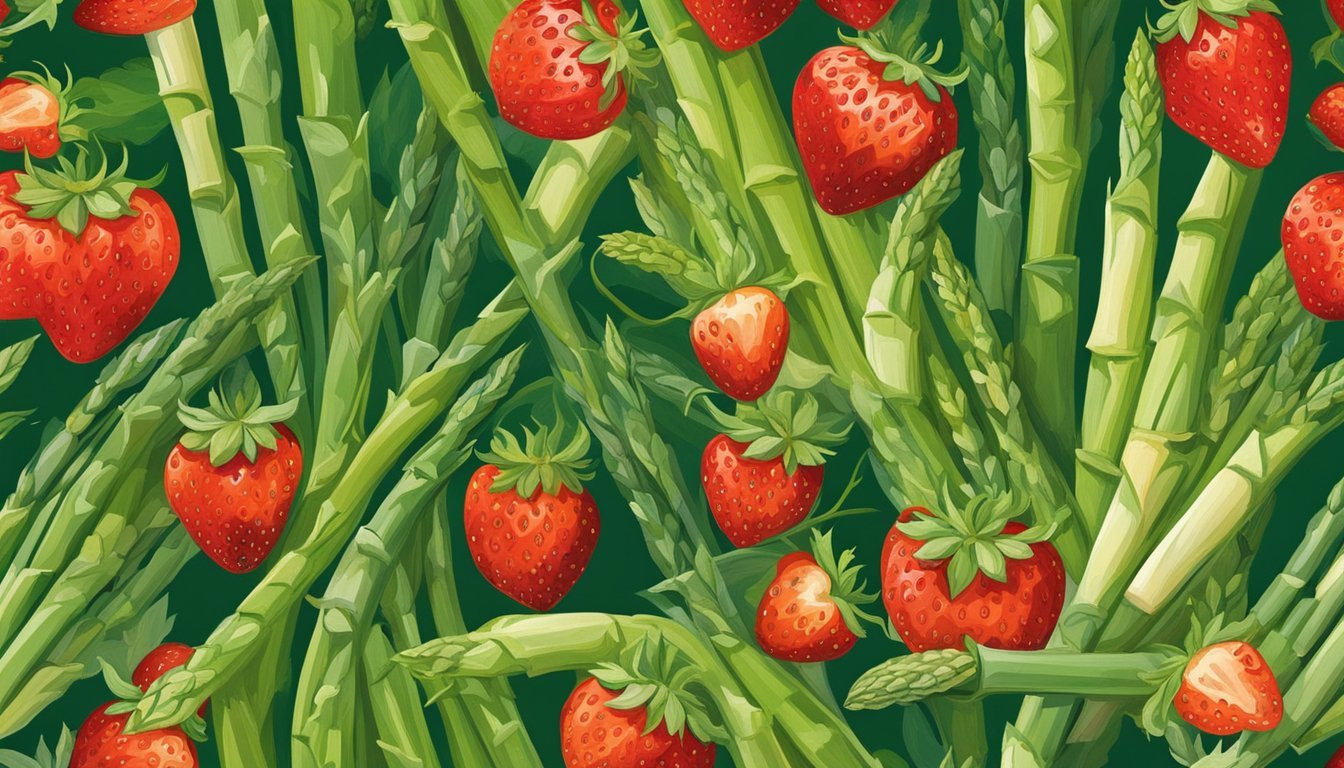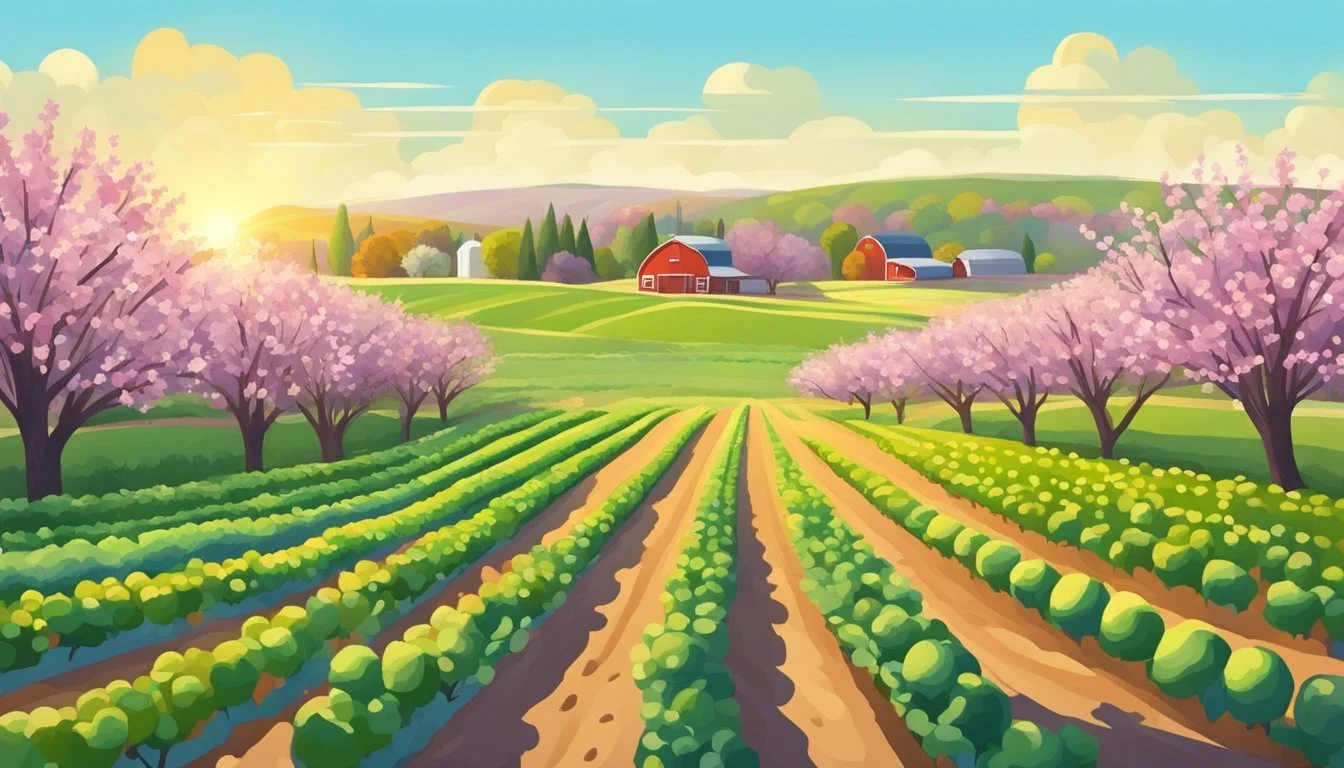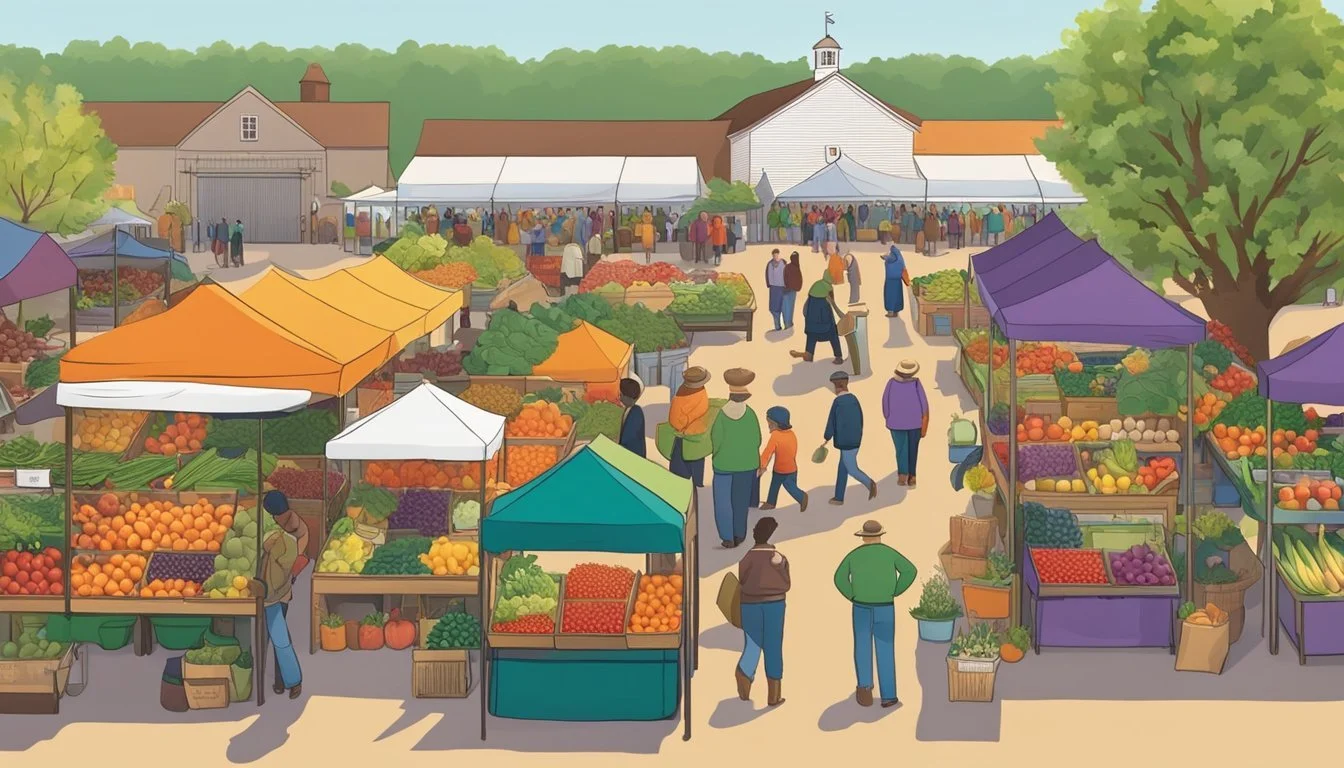Kansas Seasonal Fruit & Vegetables in March
Your Fresh Produce Guide
This Article is Part of our Kansas Seasonal Fruit & Veg Calendar
As March ushers in the early signs of spring in Kansas, the agricultural focus shifts towards preparing for the planting season. This time of year is pivotal for farmers and gardeners who begin to cultivate a variety of vegetables suited to the cooler temperatures. While the winter chill still lingers, the soil thaws and becomes primed for certain hardy crops.
Vegetables such as lettuce, spinach (What wine goes well with spinach?), and radishes take center stage in March, with the cool weather providing ideal growing conditions for these crops. Home gardens and local farms start to see the emergence of green as these vegetables begin their growth cycle. Onions and peas, too, are commonly planted during this time, as they can withstand the cool nights and gradually warmer days.
March in Kansas is not a prime time for a vast array of fresh fruit; however, stored apples from the previous season can still be found, offering a lingering taste of autumn's bounty. Though the range of local produce is more limited than in the bountiful summer months, the fruits and vegetables available are a testament to the region's ability to provide during the transitional seasons.
Key Harvest in March
In Kansas, March heralds the transition from winter to spring, providing optimal conditions for an array of seasonal produce to flourish. This period's key harvest includes a range of leafy greens, cruciferous and root vegetables, alongside early spring fruits.
Leafy Greens
Lettuce: A variety of lettuces are harvested, with crisp leaves ready for fresh salads.
Spinach: Tender spinach leaves are available, ideal for both raw and cooked dishes.
Kale: (What wine goes well with kale?) Hardy kale is typically ready to pick, packed with nutrients for healthy meals.
Collards: These greens are coming into season, offering a robust flavor to traditional cooking.
Chard: Chard provides colorful leaves perfect for sautéing or adding to pastas (how long does pasta last?).
Arugula: (how long does arugula last?) With a peppery kick, arugula is picked for a fresh, flavorful addition to salads.
Cruciferous Vegetables
Broccoli (how long does broccoli last?): Harvest begins for broccoli, suitable for roasting or steaming.
Cabbage: A staple in March, cabbage is versatile in applications from slaws to stews.
Brussels Sprouts: While nearing the end of their season, Brussels sprouts can still be found.
Cauliflower: (how long does cauliflower last?) Nutritious and flexible in use, cauliflower harvest continues through March.
Root Vegetables
Carrots: These continue to be available, sweet and crunchy for a variety of uses.
Radishes: Radishes add a sharp, peppery flavor to salads and side dishes.
Turnips: Turnips can be mashed or roasted for a hearty side.
Beets (how long do beets last?): Earthy and rich, beets are being pulled from the ground for a multitude of recipes.
Alliums
Onions: A foundational vegetable, onions are a staple in the March harvest.
Garlic: Ready for use, garlic adds pungent flavors to countless dishes.
Shallots: Milder than onions, shallots are available for delicate sauces and dressings.
Green Onions/Scallions: These provide a fresh, mild onion flavor suitable for garnishes and salads.
Miscellaneous Vegetables
Peas: Fresh spring peas begin to appear, perfect for brightening meals.
Fruits
Pears: While not a peak season, some varieties of pears are still accessible in storage.
Herbs and More
Cilantro: Fresh cilantro is harvested for its aromatic presence in dishes.
Parsley: Parsley starts to become available, offering a subtle, clean taste.
Mushrooms: Wild and cultivated mushrooms are collected, enhancing the umami in savory recipes.
Seasonal Eating Benefits
Eating seasonally during March in Kansas provides numerous advantages, particularly in terms of nutrition, freshness, and the support of local produce.
Nutrition: Fruits and vegetables harvested during their peak season contain optimal levels of vitamins and minerals. For instance, arugula—a spring green available in March—is high in antioxidants, vitamin K, and folate. The nutritional content of locally sourced, seasonal food tends to be higher than that of out-of-season produce since the latter may lose nutrients during long transit times.
Freshness: Seasonal produce is fresher, as it is sold soon after harvest. Freshness not only impacts taste but also preserves the natural texture and appearance of the produce. Kansas-grown beets and cabbage, which are available from storage in March, are examples of vegetables that maintain their quality well.
Local Produce: When consumers choose seasonal items, they support local farmers and the local economy. This reduces the carbon footprint associated with long-distance transportation of goods. Additionally, local produce is often more sustainable, as it doesn't require extensive shipping facilities or the use of preservatives to maintain freshness during transport.
In summary, choosing seasonal fruits and vegetables in March offers better nutritional benefits, ensures fresher produce, and supports the local farming community in Kansas. Consumers can indulge in hearty root vegetables while anticipating the arrival of spring greens like arugula, enjoying their meals with the confidence that they are making a healthful and environmentally conscious choice.
Shopping for Seasonal Produce
Seasonal produce in Kansas offers fresh and nutritious options that can support local farmers and reduce environmental impact from long-distance shipping. In March, shoppers have various avenues to source these products.
Farmers Markets
Farmers markets are a hub for fresh, local produce, where shoppers can directly support their local community. In March, they may find early spring vegetables such as:
Greens: arugula, lettuce, spinach
Root Vegetables: radishes
Alliums: scallions
Shoppers should check the specific market's schedule, as some may operate year-round while others open in late spring.
Grocery Stores
Grocery stores in Kansas typically offer a range of in-season fruits and vegetables, sometimes sourcing from local producers. During March, selection will vary but can include items like:
Leafy Greens: spinach and lettuce
Other Vegetables: asparagus, mushrooms
Consumers can look for labels indicating 'locally grown' to ensure they are purchasing items that contribute to local agricultural economies and enjoy freshness.
Community Supported Agriculture
Community Supported Agriculture (CSA) programs are an excellent way for consumers to buy directly from farmers. By joining a CSA, members receive shares of the harvest throughout the growing season. March offerings might be limited but generally include:
Early Vegetables
Herbs
Local Honey or other farm products
Participation in a CSA often requires upfront seasonal membership fees, but it guarantees regular distribution of produce and fosters a relationship with local growers.
Storing Seasonal Produce
To maintain freshness and extend the storage life of seasonal produce in Kansas during March, individuals should follow specific guidelines. Many fruits and vegetables available during this month are best kept in cool, dry areas or refrigerated to prevent spoilage.
Refrigeration
For produce such as asparagus, lettuce, and spinach, refrigeration is key. They should be stored in the crisper drawer of the refrigerator to preserve their crispness and prevent wilting. Here's a concise list for quick reference:
Asparagus: Stand them upright in a container with water at room temperature, then refrigerate.
Lettuce/Spinach: Wrap in a damp cloth and store in the crisper section.
Cool, Dry Storage
Items like potatoes and onions prefer a cool, dry, and dark environment, which helps prevent sprouting and decay. A pantry or cellar can be ideal for these vegetables.
Room Temperature
While most March produce benefits from refrigeration, some items like ripe tomatoes are best kept at room temperature away from direct sunlight.
Tips for Longer Storage
Always clean your produce before storing to remove dirt that can harbor bacteria.
Use airtight containers or plastic bags to protect produce from ethylene gas, which can cause premature ripening.
Monitor humidity levels, especially in refrigerated environments, as too much moisture can lead to mold.
Preparing Seasonal Dishes
March in Kansas offers a bounty of seasonal produce that can be used in an array of dishes from fresh salads to hearty cooked meals (how long do cooked meals last?). Utilizing these ingredients at their peak ensures dishes are packed with flavor and nutrients.
Salads and Raw Consumption
Lettuce, spinach, and kale make an excellent base for salads. These leafy greens are crisp and nutrient-dense, coming into season in Kansas this time of the year.
Lettuce: A versatile green, perfect for a classic green salad.
Spinach: Add to salads or serve as a side dish, simply dressed with olive oil and a pinch of salt.
Kale: Sturdy enough for salads that won’t wilt quickly, especially when massaged with dressing.
Using carrots and cabbage which are also in season, they can add crunch and sweetness to salads or slaws when sliced thinly or shredded.
Cooked Dishes
Hearty vegetables like broccoli, Brussels sprouts, and cauliflower are well-suited for cooking, lending themselves to flavorful dishes.
Broccoli: Ideal for stir-fries, steaming, or roasting with a drizzle of olive oil and seasoning.
Brussels sprouts: Can be roasted to caramelized perfection, or shredded and quickly sautéed.
Cauliflower: Roast whole for a dramatic presentation, or make 'cauliflower steaks' as a vegetarian centerpiece.
Cabbage is excellent for sautéing or adding to soups and stews. It becomes sweet and tender when cooked and can also be used in traditional dishes like cabbage rolls.
Preservation Techniques
Preserving March's produce allows one to extend the enjoyment of these vegetables well beyond their seasons. Jams, canning, and other preservation methods work well for this purpose.
Carrots and Brussels sprouts: Can be pickled to create a tangy condiment.
Cabbage: Ideal for fermenting into sauerkraut or kimchi (how long does kimchi last?), combining both preservation and flavor enhancement.
For greens like kale and spinach, blanching and freezing can retain their quality, making them available for future use in cooked recipes. It is essential to dry them thoroughly before freezing to prevent ice crystals from forming.
Understanding Kansas's Growing Seasons
In Kansas, the growing seasons reflect the Midwestern climate, with a range of temperatures that demand flexibility from gardeners and farmers. Winter lasts through December to February and is typically too cold for most crops, although some hardy vegetables can tolerate the frigid conditions.
Spring arrives in March, bringing with it a transitional climate suitable for cold-tolerant crops. Gardeners in Kansas start to plant robust vegetables like:
Onions
Beets
These vegetables can manage the still-cool soil and air temperatures.
The summer months, from June to August, elevate temperatures significantly, making it conducive for warm-season plants. This is when most of the Kansas produce flourishes, including a variety of fruits and vegetables like tomatoes, corn, and melons.
As fall approaches in September through November, Kansas growers often plant crops that can be harvested before the first frost. Cooler temperatures again become advantageous for a different set of produce. The cycle implies a necessity for strategic planting and harvesting times to maximize yield.
Here’s a snapshot of Kansas’s typical produce availability by season:
Season Produce Examples Winter Limited options, mostly storage crops Spring Lettuce, Spinach, Peas Summer Tomatoes, Peppers, Melons, Sweet Corn Fall Squash, Apples, Pumpkins
Each season distinctly affects what and how one can grow, thus knowledge of Kansas's varied growing seasons is essential for success in local agriculture.
Gardening Tips for Kansas Residents
In Kansas, March heralds the arrival of spring, a crucial time for gardeners to prepare for planting. As the state mainly falls in USDA Hardiness Zones 6 and 7, certain cool-season fruits and vegetables thrive when sown at this time.
Soil Preparation: Before planting, Kansas gardeners should ensure their soil is ready. This involves testing the soil pH and nutrient levels and amending it with organic matter to improve its structure and fertility. Tilling the soil when it's dry enough to avoid compaction is essential.
Choosing Crops: Gardeners should select varieties that are known to perform well in Kansas's diverse climate.
Cool-Season Vegetables: Onions, beets, broccoli, and spinach can be sown directly into the ground as they can withstand the still-cool temperatures of a Kansas March.
Fruit Trees & Berries: While planting times may vary, March is typically suitable for planting bare-root fruit trees and berry bushes.
Watering: Early plantings may not require as much water, but ensure the soil stays moist, especially as the seeds germinate and begin to grow.
Pest Control: It's also a prudent time to plan for pest control. Gardeners should monitor for pests and diseases and employ preventative measures, such as crop rotation and the use of environmental-friendly pesticides.
Frost Protection: Gardeners should remain vigilant about late frosts and have protective measures, like frost blankets or cloches, ready to shield young plants.
By adhering to these tips, gardeners in Kansas can confidently prepare for a fruitful growing season.
Supporting Local Kansas Agriculture
Kansas thrives on its agricultural sector and local communities play a pivotal role in sustaining this. Farmers in Kansas cultivate a rich variety of fruits and vegetables that are brought to market, especially during the peak growing seasons. Farmers markets are among the most direct ways consumers can support these local growers.
During March, consumers have the opportunity to kickstart the season by visiting local farmers markets and investing in locally-grown produce, which, in turn, nurtures the community's economy. Shopping locally not only bolsters community relationships but also ensures that the fruits and vegetables one enjoys are at their peak freshness and nutritional value.
The Kansas Department of Agriculture actively supports local farmers through programs like the Local Food Purchase Assistance program. This initiative bridges the gap between Kansas producers and the community, enhancing food security and ensuring that local dollars stay within the state, benefitting Kansans.
By supporting Kansas local agriculture, consumers help maintain a sustainable food system. As they buy from local producers, they are not just purchasing fresh produce but are also reinforcing community vitality and contributing to a smaller environmental footprint due to reduced transportation of goods.
Seasonal Availability in March:
Fruits: Limited due to seasonality, but options may include stored apples from last season.
Vegetables: Hardy winter varieties and spring greens, such as kale and lettuce.
Supporting Kansas agriculture is an act of community building, ensuring that while consumers enjoy fresh, local produce, Kansas farmers can continue to grow and thrive.










